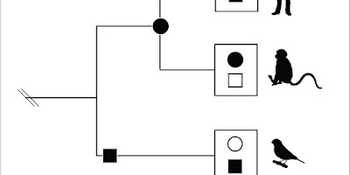Music MattersA blog on music cognition
A blog on music cognition, musicality and related matters.
2024

Interested in a challenging postdoc position in Amsterdam?
We are currently looking for a postdoc researcher that likes to work on the intersection of music cognition, biology, and the cognitive sciences. If you are excited about doing this kind of research in an interdisciplinary environment, with a team of smart and friendly colleagues, then you may want to join us.
More information, including details on how to apply, will be made available soon at our website.
Deadline for applications : 1 December 2024.

Interested in doing a PhD in Music Cognition?
Master students of the UvA (or excellent external candidates) are invited to submit a short proposal to be selected as a candidate for NWO's PhD in the Humanities programme.

Musical Animals: Are We? Can There Be?
Roughly ten years ago, I had the honor of being invited by the Barenboim-Said Akademie to deliver a public lecture in Berlin, Germany. The event, entitled Was Musik kann (What Music Can Do), celebrated the impact of music and musicianship on our lives. In my presentation I started with a listening experiment, in a playful attempt to challenge the audience.
I invited the attendees—many of whom were professional musicians and distinguished educators at the Barenboim-Said Academy—to envision themselves as expert judges on a conservatory selection committee. They were asked to assess the musicianship of an ensemble based solely on a brief excerpt of a live recording I played for them. Emulating the traditional audition process, where candidates perform behind a curtain to ensure impartiality, I asked the audience to make their judgments based solely on what they heard.
The audience's reaction was split; some were enthusiastic, while others were unimpressed. When asked for their thoughts, the positive responders praised the performance as experimental yet well-executed, whereas the negative ones criticized the timing as sloppy and the music as lacking melody. However, their opinions shifted dramatically after viewing a original video of the musicians: a group of Thai elephants, led by a human conductor, that were playing an array of percussion instruments and a mouth harmonica (see video registration).
This example is not just amusing; it also highlights some pitfalls in the study of the biology of music. Although I influenced the audience by framing the test as an audition, their varied reactions reveal more about human perception than about the elephants’ musical abilities. This raises a fundamental question: what must an organism—whether human, elephant, or bird—perceive to experience something as music? For instance, while the songs of an Amazonian songbird may sound musical to us, this perception reflects our own biases. To truly understand a bird's sense of musicality, we must ask whether the bird hears its own song as music. This inquiry shifts the attention from studying the structure of music to studying the structure of musicality.
Over the last two decades it has become evident that humans share a natural predisposition for music, akin to our inherent capacity for language (Hagoort, 2019). This predisposition, which I like to term musicality, encompasses a set of traits that develops spontaneously, is shaped by our cognitive abilities, as well being constrained by its underlying biology. Unlike music itself, which varies across cultures and societies, musicality refers to the cognitive and biological capacities that enable us to perceive and appreciate music, even among those who may not play an instrument or sing out of tune (Honing et al., 2015).
The shift in the study of the origins of music, from studying the structural aspects of music to trying to understand the structure of our capacity for music, marks an important change in perspective in music research, as reflected in the titles of two foundational meetings and their resulting publications: The Origins of Music (Wallin et al., 2000) and, consequently, The Origins of Musicality (Honing, 2018b). While the cross-cultural study of the structure of music (melodic patterns, scales, tonality, etc.) has offered exciting insights (Mehr et al., 2019; Savage et al., 2015), the approach used in these studies is indirect: the object of study here is music—the result of musicality—rather than musicality itself. Hence it is virtually impossible to distinguish between the individual contributions of culture and biology. For example, it is not clear whether the division of an octave into small and unequal intervals in a particular musical culture results from a widespread theoretical doctrine or from a music perception ability or a biological constrained predisposition.
All this is an important motivation to study the structure of musicality– i.e. the capacity for music–, its constituent components (see Table 1), and how these might be shared with other animals, aiming to disentangle the biological, cultural and environmental contributions to the human capacity for music. All these are topics that are elegantly addressed in the current volume.
[This text is a fragment of a preliminary version of an introductory chapter of The Biology of Music (Ravignani, in press)]
Ravignani, A. (ed.) (in press) The Biology of Music: Interdisciplinary Insights. Oxford: Oxford University Press.

Do you know a parrot that talks or sings?
![Ben jij muzikaal? [Dutch]](/static/c182797325ca3ad26e476b9ec104d5a1/17e6c/thkids.png)
Ben jij muzikaal? [Dutch]

Why do humans sing? |ヒトはなぜ歌うのか
Below a trailer of a Japanese documentary on the origins of musicality, made by NHK, entitled Why do humans sing? (ヒトはなぜ歌うのか ).
The one hour documentary presents cross-species and cross-cultural research on musicality, realized and filmed in Amsterdam, Inuyama, Boston and the rainforest of Central Africa.
For more information see NHK | Frontiers.

A musical ape?
Music is universal in all human cultures, but why? What gives us the ability to hear sound as music? Are we the only musical species–or was Darwin right when he said every animal with a backbone should be able to perceive, if not enjoy music?
This episode was written and produced by Ray Pang and Meredith Johnson. Sound design, mixing, and scoring by Ray Pang. The editor is Audrey Quinn. Theme music by Henry Nagle, additional music by Blue Dot Sessions and Lee Roservere.
Listen to the podcast here.

Interested in the origins of musicality?
Next week prof. Aniruddh D. Patel will visit the Netherlands to discuss his work on the origins and evolution of musicality, with a public talk at the MPI Colloquium Series in Nijmegen on Tuesday 19 March 2024 and a scientific (invitation-only) workshop on Friday 22 March 2024 in Amsterdam.
N.B. The public talk can be viewed via MPI's live stream.
![Heb jij ritmegevoel? [Dutch]](/static/3aafcac7fe10e4e7bd2611cbb91e0e63/a45e6/uvn.jpg)
Heb jij ritmegevoel? [Dutch]
"Ritmegevoel, je denkt misschien dat je het niet hebt. Maar er is wereldwijd maar bij 6 mensen vastgesteld dat ze het verschil tussen ritmes écht niet kunnen horen. Je hebt dus wel degelijk ritmegevoel. Sterker nog... uit het onderzoek van Henkjan Honing (onderzoeker muziekcognitie aan de Universiteit van Amsterdam) blijkt dat dit niet alleen is aangeleerd, maar aangeboren. Zelfs baby's van een paar dagen oud hebben het door als je iets aan de regelmaat van muziek verandert. En ook sommige apen gaan spontaan bewegen op muziek. Hoe Henkjan hierachter kwam, en waarom we überhaupt ritmegevoel hebben, leer je in deze video."
Meer lezen? Hieronder enkele van de studies die genoemd worden in de video:
- Baby's : https://doi.org/10.1016/j.cognition.2023.105670
- Makaken : https://doi.org/10.3389/fnins.2018.00475
- Chimpansees : https://doi.org/10.1073/pnas.1910318116
- Hersenen : https://doi.org/10.3389/fnins.2013.00274
- Boek : Aap slaat maat: Op zoek naar de oorsprong van muzikaliteit bij mens en dier
- Wetenschappelijke video summary : ICMPC,Tokyo, J
2023

Feel like a musical memory challenge?
[Blog by Jiaxin Li on TeleTunes]
Think about your favorite TV show. Can you hear the theme music already starting to play in your mind? Maybe it’s the epic sounding strings from Game of Thrones or the punchy synthesizer from Seinfeld? You’ve probably heard the music from that show so many times it’s now encrypted in your memory. As music cognition researchers, we are eager to find out what makes some TV tunes more memorable than the others.
The TeleTunes game is designed for exactly this reason. It is a game that allows us to study the catchiness of TV themes. Unlike the Christmas or Eurovision versions of our Hooked-on Music game series, this game invites you to test your memory with clips from the most iconic TV themes, curated from IMDB’s 100 most watched shows and The Rolling Stone’s esteemed “Greatest” TV show lists spanning the past 40 years. Your challenge? If you recognise a tune, quickly click the button, sing along in your mind and judge whether after a few seconds it continues in the right spot.
Through engaging in this game, you are contributing to music science, enriching our understanding of musical memory. By investigating the familiarity of these TV tunes, we are building a corpus consisting of well-known music. In the near future, we will use the results for yet another game – TuneTwins – continuing our quest to investigate questions like “what makes music memorable” or even “how do we as human beings remember music”.
We hope you will enjoy this game. Each game takes only a few minutes, and you can play it as many times as you like. Listen carefully! The fewer mistake you make, the more points you’ll earn! Finally, feel free to share the link with your friends and family and see who can get the highest score. The more you play, the more you contribute to science!
TeleTunes can be found at: https://app.amsterdammusiclab.nl/teletunes.

Interested in a one-year postdoc position?
We are looking for a postdoc researcher that likes to work on the intersection of music cognition, psychometrics, and the cognitive sciences. If you are excited about doing this kind of research in an interdisciplinary environment, with a team of smart and friendly colleagues, then you may want to join us.
More information, including details on how to apply, can be found at the UvA website.
Deadline for applications : 15 January 2024.

Why did we decide to revisit and overhaul our earlier beat perception studies?
[Published in Scientific American and MIT Press Reader]
In 2009, we found that newborns possess the ability to discern a regular pulse – the beat – in music. It’s a skill that might seem trivial to most of us but that’s fundamental to the creation and appreciation of music. The discovery sparked a profound curiosity in me, leading to an exploration of the biological underpinnings of our innate capacity for music, commonly referred to as “musicality.”
In a nutshell, the experiment involved playing drum rhythms, occasionally omitting a beat, and observing the newborns’ responses. Astonishingly, these tiny participants displayed an anticipation of the missing beat, as their brains exhibited a distinct spike, signaling a violation of their expectations when a note was omitted. This discovery not only unveiled the musical prowess of newborns but also helped lay the foundation for a burgeoning field dedicated to studying the origins of musicality.
Yet, as with any discovery, skepticism emerged (as it should). Some colleagues challenged our interpretation of the results, suggesting alternate explanations rooted in the acoustic nature of the stimuli we employed. Others argued that the observed reactions were a result of statistical learning, questioning the validity of beat perception being a separate mechanism essential to our musical capacity. Infants actively engage in statistical learning as they acquire a new language, enabling them to grasp elements such as word order and common accent structures in their native language. Why would music perception be any different?
To address these challenges, in 2015, our group decided to revisit and overhaul our earlier beat perception study, expanding its scope, method and scale, and, once more, decided to include, next to newborns, adults (musicians and non-musicians) and macaque monkeys.
[...] Continue reading in The MIT Press Reader.

Do babies have a natural affinity for ‘the beat’ ?
‘There is still a lot we don't know about how newborn babies perceive, remember and process music,’ says author Henkjan Honing, professor of Music Cognition at the UvA. 'But, in 2009, we found clear indications that babies of just a few days old have the ability to hear a regular pulse in music – the beat – a characteristic that is considered essential for making and appreciating music.’
27 babies
Because the previous research from Honing and his colleagues had so far remained unreplicated and they still had many questions, the UvA and TTK joined forces once again – this time using a new paradigm. In an experiment with 27 newborn babies, researchers manipulated the timing of drum rhythms to see whether babies make a distinction between learning the order of sounds in a drum rhythm (statistical learning) and being able to recognize a beat (beat-induction).
Manipulated timing
The babies were presented with two versions of one drum rhythm through headphones. In the first version, the timing was isochronous: the distance between the sounds was always the same. This allows you to hear a pulse or beat in the rhythm. In the other version, the same drum pattern was presented, but with random timing (jittered). As a result, beat perception was not possible, but the sequence of sounds could be learned. This allowed the researchers to distinguish between beat perception and statistical learning.
Because behavioral responses in newborn babies cannot be observed, the research was done with brain wave measurements (EEG) while the babies were sleeping. This way, the researchers were able to view the brain responses of the babies. These responses showed that the babies heard the beat when the time interval between the beats was always the same. But when the researchers played the same pattern at irregular time intervals, the babies didn't hear a beat.
Not a trivial skill
‘This crucial difference confirms that being able to hear the beat is innate and not simply the result of learned sound sequences,’ said co-author István Winkler, professor at the Institute of Cognitive Neuroscience and Psychology at TTK. 'Our findings suggest that it is a specific skill of newborns and make clear how important baby and nursery rhymes are for the auditory development of young children. More insight into early perception is of great importance for learning more about infant cognition and the role that musical skills may play in early development.'
Honing adds: 'Most people can easily pick up the beat in music and judge whether the music is getting faster or slower – it seems like an inconsequential skill. However, since perceiving regularity in music is what allows us to dance and make music together, it is not a trivial phenomenon. In fact, beat perception can be considered a fundamental human trait that must have played a crucial role in the evolution of our capacity for music.’
Publication details
Gábor P. Háden, Fleur L. Bouwer, Henkjan Honing and István Winkler. Beat processing in newborn infants cannot be explained by statistical learning based on transition probabilities, Cognition, DOI 10.1016/j.cognition.2023.105670.
[Source UvA Press Office: English version; Dutch version.]

Interested in doing a PhD in Music Cognition?
Master students of the UvA (or excellent external candidates) are invited to submit a short proposal to be seleted as candidate for NWO's PhD in the Humanities programme.

How to keep a forest happy?
A new study on the possible evolutionary origins of music [Press Release]
[Newspaper article in Dutch]
Why is music so prevalent and universal in human societies? Does music serve an adaptive function, or it is just “auditory cheesecake”, as cognitive psychologist Steven Pinker infamously claimed: a delightful dessert but, from an evolutionary perspective, no more than a by-product of language?
The debate on the origins of music has intrigued scientists for centuries. The hypotheses range from music being a mating display in order to woo females, to a means to increase social bonding in group contexts. For the first time, a group of international and interdisciplinary researchers led by Karline Janmaat and her former MSc Student Chirag Chittar, have tested several hypotheses on music simultaneously in a modern foraging society during their daily search for food. They found that women during tuber finding events were more likely to sing in large groups of strangers and less likely to sing in large groups of individuals they knew. The study was part of an elaborate longitudinal study spanning 2 years and has now been published in Frontiers in Psychology.
Music makes the forest happy
“We know from their communication about music that the BaYaka sing to “please the forest” so that it provides them with more food. What they dislike most is conflict, as they believe it would make the forest spirits angry. What intrigues me the most is that our behavioral observations nicely complement their verbal communication about music. The women sing more frequently when they search for food in groups that are large and contain fewer “friends”, in which conflicts about food are more likely to arise. To me, our study reveals that these foragers appear to use music as a tool to avoid potential future conflict. How amazing is that?!”, Janmaat says.
“This study gives important empirical insights in the possible origins of music, a topic that for long had to be mere speculation”, says coauthor Henkjan Honing, professor of Music Cognition at UvA. “It made us decide to intensify our interdisciplinary collaboration and to further study the role of music with the BaYaka in a project aiming to unravel the human capacity for music. We are excited to announce our plans to return to this captivating society next year, where music appears to occupy a central role that transcends language.”
Chittar, C., Jang, H., Samuni, L, Lewis, J, Honing, H., Van Loon, E.E., Janmaat, K.R.L. (2023). Music and its role in signaling coalition during foraging contexts in a hunter-gatherer society. Frontiers in Psychology. doi 10.3389/fpsyg.2023.1218394.

Interested in contributing to our web-based music science platform?
More information on how to apply can be found here.
Deadline for applications is 31 October 2023.

Did you enjoy playing the game Memory?
Did you enjoy playing the game Memory as a child? You can now play the game with music instead of pictures! Say hello to the TuneTwins!
Researchers from the Music Cognition Group at the University of Amsterdam developed this game to answer important scientific questions about our perception and memory of music.
In TuneTwins, you are challenged to match identical or similar tune pairs. These are taken from the 100 most popular TV themes according to IMDB and The Rolling Stone!
Each game would only take a few minutes and you are welcome to play it as many times as you want. The more you play, the more you contribute to science!
You can find a tutorial and a link to the game here.

What is the use of the comparative approach in studying the origins of language and music?
Comparative studies can be done in several ways. One approach is to examine the sounds made by animals and look for shared features or parallels with language or music. To study these, one can, for example, examine how the structure of a sequence of sounds compares to syntactic structures in language or rhythmic structures in music, or whether harmonic sounds are recognized by their pitch (like in music) or by their spectral structure (like in speech). The presence of such features can indicate that similar sensory or cognitive mechanisms may underlie their perception and production and those needed for language and music in humans. However, one needs to be cautious with drawing such conclusions. That a sound produced by an animal has certain features in common with language or music may be incidental and a result of human interpretation, rather than indicating shared mechanisms per se. Animal sounds showing, for example, a specific rhythmic pattern (e.g., in the call of the indri, a lemur species; De Gregorio et al., 2021) or that contain tones based on a harmonic series (e.g., in the hermit thrush; Doolittle et al., 2014), need not indicate an ability of the animal to perceive or produce rhythms or harmonic sounds in general, as is common in humans. To show this, it is necessary to demonstrate the perception or production of such patterns outside and beyond what is realized in the species-specific sound patterns. This requires a second approach: using controlled experiments to address whether animals can (learn to) distinguish and generalize artificially constructed sounds that differ in specific linguistic or musical features. The two approaches, observational-analytical and experimental, are complementary: the first one may hint at presence of a certain ability, while the second one can test its existence and the limits of the capacity (Adapted from: ten Cate & Honing).
De Gregorio, C., Valente, D., Raimondi, T., Torti, V., Miaretsoa, L., Friard, O., Giacoma, C., Ravignani, A. & Gamba, M. (2021). Categorical rhythms in a singing primate. Current Biology, 31(20), R1379–R1380. https://doi.org/10.1016/j.cub.2021.09.032
Doolittle, E. L., Gingras, B., Endres, D. M. & Fitch, W. T. (2014). Overtone-based pitch selection in hermit thrush song: Unexpected convergence with scale construction in human music. Proceedings of the National Academy of Sciences, 11(46), 1–6. https://doi.org/10.1073/pnas.1406023111
Ten Cate, C. & & Honing, H. (2023, in press). Precursors of Music and Language in Animals. Sammler, D.
(ed.) Oxford Handbook of Language and Music Oxford: Oxford University Press. Preprint: psyarxiv.com/4zxtr.

What is your position on the possible origins of music/ality?
This blog-entry adds several new analyses and visualizations related to the topic of the origins of music/ality, as discussed in a recent issue of Behavioral and Brain Sciences (BBS; cf. Mehr et al., 2021; Savage et al., 2021).
N.B. An interactive app, linking to the two target articles, the 60 commentaries, as well as the commentaries' position in this debate, can be found on GitHub.
The analyses presented below are based on a questionnaire that was send to the 60 commentary writers in 2021.
Fig. 1 shows the outcome of that questionnaire asking to rate one's own position w.r.t. the two target articles on a five point scale from Strongly Critical to Strongly Supportive (N.B. We received 49 responses):
Fig. 2 below shows the rating provided by Savage et al. (2021), where two raters judged the positions of all commentaries on the same two dimensions (but on a continuous scale):
Furthermore, we also did some simple numerical comparisons between the data presented in Fig. 1 and 2. The main observations are:
-
For the Social Bonding hypothesis there is an agreement* between ratings shown in Fig. 1 and those of Fig.2 of <b>.62</b> (Rater 1/Authors) and <b>.69</b> (Rater 2/Authors). As such, the raters did a relatively good job in estimating the authors positions. </li><li>For the Credible Signalling hypothesis the agreement* was <b>.51</b> (Rater 1/Authors) and <b>.56</b> (Rater 2/Authors), suggesting the raters did less well in estimating the authors positions.<br></li></ol><p>*Intraclass Correlation Coefficient (ICC). Note that resolution of both ratings (Fig. 1 and 2) differ, which could affect the results.
Fig 3. shows the results on the question whether this two-dimensional representation was considered adequate by the commentary authors:
[Credits: Visualizations by Bas Cornelissen; Stats by Atser Damsma]
Mehr, S., Krasnow, M., Bryant, G., & Hagen, E. (2021). Origins of music in credible signaling. Behavioral and Brain Sciences, 44, E60. doi:10.1017/S0140525X20000345
Savage, P., Loui, P., Tarr, B., Schachner, A., Glowacki, L., Mithen, S., & Fitch, W. (2021). Music as a coevolved system for social bonding. Behavioral and Brain Sciences, 44, E59. doi:10.1017/S0140525X20000333
Honing, H. (2021). Unravelling the origins of musicality: Beyond music as an epiphenomenon of language. Behavioral and Brain Sciences, 44, E78. doi:10.1017/S0140525X20001211
2022

Interested in becoming Assistant Professor in Generative AI in Amsterdam?
Generative AI in the past decade has changed the field of artistic creativity, making us ask new questions that are relevant not only for scientific research but also for musicians and artists of all kinds. With this position, we are seeking to broaden our profile with respect to AI-assisted music generation and how AI-generated art can be positioned within the humanities and cognitive science more generally. The explosive growth of creative AI has also brought new ethical and epistemological dimensions to reflect upon, and we are looking for a colleague who can translate this reflection into both teaching and research. The ideal candidate will be somebody comfortable engaging in the ethics and implications of using AI in artistic processes regardless of medium, with more specific expertise in how AI is (and can be) used to make music.
See here for all information on how to apply.
Deadline for applications: 12 January 2023.
Wat is een absoluut gehoor en is het erfelijk? [Dutch]
Niet zo lang geleden verscheen op het internet een video [zie hieronder een nwe versie] met de tekst: ‘Kijk eens wat deze hond kan. Hij is muzikaler dan ik!’
De video laat een golden retriever zien die geconcentreerd naar zijn baas kijkt die tegenover hem zit. Als zij een toon laat horen reageert de hond door met zijn poot een toets in te drukken op een fors pianotoetsenbord dat voor hem op de grond ligt. Welke toon het baasje ook speelt, de hond herhaalt zonder aarzeling precies dezelfde toon op de piano. ‘Hij heeft absoluut gehoor!’ voegt een lezer al snel als commentaar aan de video toe. En dat klopt. De meeste dieren hebben absoluut gehoor, in de zin dat zij klanken onthouden en herkennen aan de absolute frequentie (het trillingsgetal) van het geluid, en niet zozeer aan het melodische verloop of de intervalstructuur, zoals wij mensen dat doen. Wij vinden absoluut gehoor daarom bijzonder. Als je aan musici vraagt een voorbeeld te noemen van een bijzondere muzikale vaardigheid dan noemen velen als eerste ‘absoluut gehoor’. Iemand met een absoluut gehoor kan een willekeurig aangeslagen pianotoon benoemen zonder gezien te hebben welke toets er werd ingedrukt. Vooral voor conservatoriumstudenten is dat handig, omdat zij dan minder moeite hebben met de muzikale dictees die ze regelmatig krijgen: het in notenschrift opschrijven van wat de docent voorspeelt of zingt.
Maar terug naar de golden retriever. Ik denk dat hij inderdaad de pianotonen aan hun frequentie kan herkennen. Maar ik vermoed ook dat als er een gordijn tussen hem en zijn baasje gehangen wordt, hij deze ingewikkelde taak niet meer vlekkeloos uitvoert. Deze hond doet immers meer dan alleen een toon herkennen aan zijn trillingsgetal. De term absoluut gehoor is wat dat betreft te beperkt. De hond moet namelijk behalve een toon horen, herkennen en herinneren, deze ook classificeren (is het een c of een cis?), bepalen welke toets daarbij hoort en deze vervolgens aanslaan op het grote toetsenbord dat voor hem ligt. Op de video zijn de ogen van de golden retriever en die van zijn eigenaar niet te zien, maar het zou me niet verbazen als de hond vooral haar blik volgt om te weten welke toets hij verwacht wordt aan te slaan, in plaats van zijn absolute gehoor. Het zou heel goed kunnen dat het klassieke Pavlov-effect – als ik doe wat baasje van mij verlangt, krijg ik een beloning – hier sterker is. (Dit is eenvoudig te testen door een gordijn tussen hond en baas te hangen. Voorspelling: de hond kan de taak niet meer vlekkeloos uitvoeren.)
Absoluut gehoor is dus niet zo zeer een gehoorvaardigheid, zoals de term suggereert, als wel een cognitieve vaardigheid. Het bestaat uit zeker twee aspecten: je moet je een toon kunnen herinneren en vervolgens een naam geven. Daarnaast moet je voor dat laatste een toon – of hij nou door een piano, viool, stem of fluit wordt voortgebracht – kunnen classificeren als behorende tot eenzelfde categorie en hem vervolgens benoemen.
Het eerste is een wijdverspreide vaardigheid die je eenvoudig kan testen. Stel je een bekend liedje voor, bijvoorbeeld Stayin’ alive van de Beegees, en zing het vervolgens. Grote kans dat de toonhoogte precies overeenkomt met het origineel. Wij mensen kunnen (net als veel andere dieren) heel goed de toonhoogte onthouden van bijvoorbeeld popliedjes of tv-tunes die we goed kennen. Maar een enkele toon horen en vervolgens weten of het een c is of een cis is een bijzondere vaardigheid die bij minder dan 1 op de 10.000 mensen voorkomt.
Er zijn goede reden om absoluut gehoor te zien als het resultaat van een genetisch bepaalde aanleg. Diverse studies laten zien dat bepaalde chromosomen betrokken zijn bij het wel of niet hebben van de vaardigheid (zoals chromosoom 8q24.21). Daarnaast zijn er neurowetenschappelijke studies die anatomische verschillen tussen mensen met en zonder absoluut gehoor laten zien, met name in de temporaalkwab en diverse corticale gebieden.
Niet alleen lijkt absoluut gehoor een genetische component te hebben en dus erfelijk te zijn, het ontwikkelen ervan is hoogstwaarschijnlijk het resultaat van blootstelling aan muziek op jonge leeftijd en intensieve muzikale training. In een land als Japan komt absoluut gehoor veel vaker voor dan elders. Bij Japanse conservatoriumstudenten loopt het percentage soms op tot wel 70 procent. Dat zou verklaard kunnen worden door het feit dat het een land is waar muziek een belangrijke plaats heeft in het onderwijs aan jonge kinderen.
Maar voor zover we weten heeft absoluut gehoor niet zo veel met muzikaliteit te maken heeft. Mensen met absoluut gehoor zijn over het algemeen niet muzikaler dan andere mensen. Sterker nog: de overgrote meerderheid van de westerse professionele musici heeft helemaal geen absoluut gehoor.
Ivan Pavlov ontdekte al in het begin van de vorige eeuw dat honden een enkele toon konden onthouden en associëren met bijvoorbeeld eten. Ook van wolven, en ratten, is bekend dat zij soortgenoten herkennen aan de absolute toonhoogte van hun roep, en dus onderscheid kunnen maken tussen de ene en de andere toon. En voor spreeuwen en resusapen, is dat niet anders, zo suggereren verschillende studies.
Een veel muzikaler vaardigheid is ‘relatief gehoor’ – het herkennen van een melodie, los van de precieze toonhoogte waarop die klinkt of gezongen wordt. De meeste mensen luisteren niet naar de afzonderlijke tonen en hun trillingsgetal, maar naar de melodie als geheel. Of we Altijd is Kortjakje ziek nou lager of hoger gezongen horen worden, we herkennen het liedje toch wel.
Het horen van verbanden en relaties tussen de tonen, in zowel melodische als harmonische zin, is deel van het plezier van het luisteren naar muziek. Het maakt de vraag of we relatief gehoor met andere diersoorten delen, inclusief honden, een van de centrale vragen in het onderzoek naar de biologische basis van de menselijke muzikaliteit.
Uit: Honing, H. (2017). Wat is een absoluut gehoor en is het erfelijk? In Rinnooy Kan & de Graaf (eds.), Hoe zwaar is licht? (pp. 74-76). Amsterdam: Uitgeverij Balans.
![Wil je ontdekken hoe het zit met je absoluut en relatief gehoor? [Dutch]](/static/bf353ff6d9cedf93a71dc8b0efd37ff0/e21b2/atlas.jpg)
Wil je ontdekken hoe het zit met je absoluut en relatief gehoor? [Dutch]
Kun jij horen welke versie van de intro van Wie de mol? of The Walking Dead de juiste toonhoogte heeft? En lukt het je om van een superkort fragment de titel en artiest van een nummer herkennen? Ontdek hoe het zit met je absoluut en relatief gehoor, je gevoel voor ritme en timing, en je geheugen voor muziek. Je bent waarschijnlijk muzikaler dan je denkt. Speel de mini-games op ToontjeHoger en leer tegelijkertijd meer over muzikaliteit.
ToontjeHoger is ontwikkeld door de muziekcognitiegroep van de Universiteit van Amsterdam. Speel de minigames hier.

Can you do better than a songbird?
Note that –like the zebra finches– you will get no explicit instruction, just some simple feedback on whether your answer is correct (smiley), incorrect (sad face), or not in time (question mark).
After this you will enter the main phase of the experiment in which you
are asked to simply continue responding to the sound sequences as you
did before. Note that, in this final phase, you will only occasionally
receive feedback.
Can you do as well, or even better than a songbird?
The online experiment can be found here.

Interested in doing a PhD in music cognition?
Are we born to be musical?
This is the first episode of The Rhythm of Life, a series from BBC Reel exploring the power of music.
![Waarom kunnen sommige mensen niet dansen? [Dutch]](/static/a3392b815e2c11d8cd3ffda1cb15c5e5/d5c9f/FB.jpg)
Waarom kunnen sommige mensen niet dansen? [Dutch]
Het Amsterdam Dance Event is begonnen. Waarom kunnen sommige mensen niet dansen?
Een gesprek met neurowetenschapper Fleur Bouwer van de Universiteit van Amsterdam. De aflevering is hier te vinden.
![Wanneer is muziek raar? [Dutch]](/static/e3a17d6a2b641343730b86a89ee23a26/d5c9f/3kih8pvmkoak-kn-de-nacht-livetegel-def.jpg)
Wanneer is muziek raar? [Dutch]
Voor wie graag naar unieke klanken luistert is 24 augusutus de ideale dag. Deze dag staat namelijk in het teken van 'Strange Music'. Het idee hierachter? Mensen kennis laten maken met klanken en melodieën die net buiten de gebaande paden treden.
Maar wat is nu eigenlijk strange music? Kunnen we bepaalde muziek wel globaal bestempelen als raar? Of schuilt hier toch meer achter?
Presentator Benji Heerschop spreekt hierover met hoogleraar muziekcognitie Henkjan Honing.
![Is muziek niet grotendeels cultureel bepaald? [Dutch]](/static/a7634ee98e45eebb13a6013b2f01de77/a45e6/D5CAE501-FBB2-4E46-A255-1B143F265B6C_1_102_o.jpg)
Is muziek niet grotendeels cultureel bepaald? [Dutch]
Interview met Henkjan Honing in de Volkskrant door Cécile Koekkoek:
"Voor de onregelmatige reeks over intuïtie, waarvoor V spreekt met deskundigen uit verschillende vakgebieden, schakelt hoogleraar muziekwetenschap Henkjan Honing (63) in via zoom vanuit zijn vakantieadres in Frankrijk. ‘Ik heb niks voorbereid, dus ik antwoord op intuïtie’, zegt hij lachend. Hij komt meteen to the point. ‘Er zijn twee vormen van weten. Het ene weten gaat uit van ervaring en het andere weten van rationele kennis. Oftewel: van impliciete en expliciete kennis. Als wetenschapper laveer je voortdurend tussen die twee."

Interested in doing a PhD in Amsterdam?
All information on how to apply can be found here.
Deadline for applications is 21 July 2022.

Was Darwin right? (New book, translated in German and Italian)
Appraisal of The Evolving Animal Orchestra (MIT Press):
"In 1871 Charles Darwin argued :
The perception, if not the enjoyment, of musical cadences and of rhythm is probably common to all animals.
Henkjan Honing has tested this eminent reasonable idea, and in his bookhe reports back. He details his disappointment, frustration and downright failure with such wit, humility and a love of the chase that any young person reading it will surely want to run away to become a cognitive scientist."
–– Simon Ings in NewScientist.
"Honing’s new
book provides a succinct, informal though rigorous overview of what we know of cross-species musicality. [..] Most science happens as a tiresome journey, and what the public sees is only the splendidness of arrival – that's not the case of this book. This is a popular science book, intriguing and entertaining."
–– Andrea Ravignani in Current Biology.
"Originally published in 2018 in the Netherlands, the new English translation by Sherry MacDonald has been eagerly awaited by students and scholars who are curious about music’s place beyond the strictly human. I believe they will not be disappointed, for Honing’s book offers a number of insights for both the amateur and the scientist in a readable prose style."
–– Rachel Mundy in Psychology of Music.
For more endorsements, see here.
For related podcasts, see HedgehogandtheFox and BigBiology.
For related documentaries, see CBC, Sky Tv and here.
For links to all the books, see here.

Do language and music share one precursor?
One way of categorizing the sensitivities of animals to the building blocks of language and music is to group these sensitivities along the frequency/spectral and temporal dimensions of sound. Although speech and music share many acoustic features, music appears to take advantage of a different set of acoustic features than speech. In humans the frequency dimension is central to music/melody perception, while for understanding speech the temporal dimension appears to be most fundamental (Albouy et al., 2020; Shannon et al., 1995). With respect to the frequency dimension of speech, humans attend primarily to the spectral structure (which enables the distinction between
the different vowels and consonants), while for music the attention appears to be less on a spectral quality (e.g., the sound of a guitar versus that of a flute), but instead on the melodic and rhythmic patterns. As such, it might well be that humans are an exception in that they can interpret the same sound signal in (at least) two distinct ways: as speech or as music (cf. speech-to-song illusion). In other animals such distinction is not observed (as yet). In humans, melody and speech are processed along specific and distinct neural pathways (Albouy et al., 2020; Norman-Haignere et al., 2022) and it could be that brain networks that support musicality are partly recycled for language (Peretz et al., 2018). This could imply that both language and music share one precursor. In fact, it is one possible route to test the Darwin-inspired conjecture that musicality precedes music and language (Honing, 2021). In a recent preprint (ten Cate & Honing, 2022) we discuss the potential components of such a precursor.
Albouy, P., Benjamin1, L., Morillon, B., & Zatorre, R. J. (2020). Distinct sensitivity to spectrotemporal modulation supports brain asymmetry for speech and melody. Science, 367(6481), 1043–1047. https://doi.org/10.1126/science.aaz3468.
Honing, H. (2021). Unravelling the origins of musicality: Beyond music as an epiphenomenon of language. Behavioral and Brain Sciences, 44(E78), 66–69. https://doi.org/10.1017/S0140525X20001211.
Norman-Haignere, S. V., Feather, J., Boebinger, D., Brunner, P., Ritaccio, A., McDermott, J. H., … Kanwisher, N. (2022). A neural population selective for song in human auditory cortex. Current Biology, 1–15. https://doi.org/10.1016/j.cub.2022.01.069.
Peretz, I., Vuvan, D. T., Armony, J. L., Lagrois, M.-É., & Armony, J. L. (2018). Neural overlap in processing music and speech. In H. Honing (Ed.), The Origins of Musicality (Vol. 370, pp. 205–220). Cambridge, Mass.: The MIT Press. http://dx.doi.org/10.1098/rstb.2014.0090.
Shannon, R. V., Zeng, F. G., Kamath, V., Wygonski, J., & Ekelid, M. (1995). Speech recognition with primarily temporal cues. Science, 270(5234), 303–304. https://doi.org/10.1126/science.270.5234.303
Ten Cate, C., & Honing, H. (2022). Precursors of music and language in animals. PsyArXiv Preprint. Retrieved from psyarxiv.com/4zxtr.

Precursors of music and language?
Language and music are universal human traits, raising the question for their evolutionary origin. In a recent review, co-authored with Carel ten Cate (LU), we take a comparative perspective to address that question.
In the chapter (ten Cate & Honing, in press) we examine similarities and differences between humans and non-human animals (mammals and birds) by addressing whether and which constituent cognitive components that underlie the human ability for language and music can be found in non-human animals.
It first provides an introduction to the nature and meaning of vocalizations and non-vocal communicative sounds in non-human animals. Next it reviews experimental and observational evidence of animal perception of various frequency and temporal dimensions of sounds. Many animal species show perceptual and cognitive abilities to distinguish between or to generalize auditory stimuli. This includes evidence of the presence of one or more of the constituent cognitive components on which the human abilities for language and music are based, or that may have served as precursors for these components. At the same time, there are also important differences among animal species in their abilities. Hence contrasts are not limited to those between humans and other animal species.
We conclude that the differences between humans and other species, as well as those among non-human species, might result from specific biases and the weight or priority certain species give to attending to certain features of an acoustic signal, or because different species use particular mechanisms to different degree.
ten Cate, C. & Honing.H. (2023, in press). Precursors of music and language in animals. In Sammler, D. (ed.), Oxford Handbook of Language and Music. Oxford: Oxford University Press. doi: psyarxiv.com/4zxtr

Interested in becoming an Assistant Professor in Computational Creativity?
Deadline for applications: 21 March 2022.
What makes music catchy?
Often you only need to hear a few seconds of music, to recognize a song. There's a good chance it was a very catchy tune. Computational musicologist Ashley Burgoyne (Music Cognition Group, University of Amsterdam) reveals what makes a song catchy.
Burgoyne, J. A., Bountouridis, D., Balen, J. van, &
Honing, H. (2013). Hooked: A Game For Discovering What Makes Music Catchy. In
A. De Souza Britto, F. Gouyon, & S. Dixon (Eds.), Proceedings of the
International Society for Music Information Retrieval Conference (pp.
245–250). Curitiba, Brazil. [pdf]
Waarom kan jouw partner niet dansen? [Dutch]
"Sta je eindelijk weer eens met je partner op de dansvloer, gaat hij nog voor het einde van het eerste nummer op je tenen staan. Hij voelt zich schuldig en jij bent teleurgesteld, want jij wil ook weleens romantisch over de dansvloer zwieren. Maar waarom kan jouw partner dat niet? Heeft-ie een slecht ritmegevoel?"
In deze Universiteit van Amsterdam lezing geeft cognitief neurowetenschapper Fleur Bouwer (Universiteit van Amsterdam, Music Cognition Goup Associate) antwoord op die vraag.
Bouwer, F.L., Honing, H., & Slagter, H. A. (2020) Beat-based and memory-based temporal expectations in rhythm: similar perceptual effects, different underlying mechanisms. Journal of Cognitive Neuroscience, 32(7), 1221-1241. doi: 10.1162/jocn_a_01529
Honing, H., & Bouwer, F. L. (2019). Rhythm. In Rentfrow, P.J., & Levitin, D. (ed.), Foundations in Music Psychology: Theory and Research. Cambridge, Mass.: The MIT Press. ISBN 9780262039277.

Interested in music and biology?
In this episode of Big Biology, entitled Beasty Beats: The Origins of Musicality, Art Woods and Marty Martin talk with Henkjan Honing about the biology of musicality:
"He started as a musician but eventually found his way to the science of music. Among diverse species, he and his collaborators now study how and why some animals perceive elements of music but others do not. We also discuss the earliest known examples of human musical instruments and the possible adaptive value of music."
Apple podcast here | Spotify podcast here | Stitcher podcast here.
Why do we value music so much; Are there biological or social explanations for this?
Below a recording of a recent, one hour+ edition of BètaBreak –made by Frank Gelens, Rianne Verhaegh, and hosted by Spui25– about what musicality entails, what its
biological underpinnings in the brain are, and why we all have musical
abilities.
"The ability to perceive rhythm, tones and beats, key components of musicality, seems to be universal across humans and manifests itself already from a young age; something that this edition’s guest endorses (Honing, 2018). Is there an underlying mechanism in our brain that makes this possible? Could our preferences in music have a biological explanation? Furthermore, is musicality also present in other species or is it a human trait?"
Honing, H. (2018). On the biological basis of musicality. Annals of the New York Academy of Sciences (The Neurosciences and Music VI: Music, Sound and Health). doi: 10.1111/nyas.13638.
For another episode of BètaBreak/Spui25 with Frans de Waal on the topic of beauty, see here (with snippets on music/ality too).
![Wat is het geheim van de cello? [Dutch]](/static/ccfb696aff5f8d8fc6316aa8de36f2d0/e21b2/AVvXsEjk7Ip5asc56OLMydv6iZCWoFjLzX4NuEeaBiIurhtC4WjlMy2yCFE4HxHkDa1kKMzME2z2ABmJX4Ap52ozT3QN718OXOyuioZzSIQ_-iYjekHCuBEY02QU-o9ZYprUapfvm4aewWmRkPIFkGgHORbWxuqIwdReqmT0kBspt9J2h_HBeXGOvCBOfwaP%3Dw400-h208.jpg)
Wat is het geheim van de cello? [Dutch]
Eerste aflevering van de podcastserie De Ontroering - Op zoek naar het geheim van de cello. Podcastserie van de Cello Biënnale Amsterdam, het grootste cellofestival ter wereld, met gesprekken, achtergrondreportages en natuurlijk muziek.
De podcast werd gemaakt door Mirjam van Hengel en Frans van Deursen.

Interested in developing a Music Related Citizen Science Infrastructure?
More information on how to apply for the position (3 years, 0.5 fte) can be found here.
Deadline for applications is 15 February 2022.
�
2021
![Geïnteresseerd om student-assistent (SA) te worden bij MCG? [Dutch]](/static/ec3e109c7973b42316f0436fbe78ec49/e21b2/AVvXsEiQNG_eJUZytxp8roabbXcVMzwoYcL7YtPY34_KwK7SvCYJohak12vS-8TotAemAi-qS0-Xxr1kv9rxBwi_9cKbz_sXmsWwM9YCugOj6smN8RsutRYVizGIcTS8AXT2PJpZ4fL4O-3GYfvZHzWixKiTYvyRebLR7ENMfPPNbREMkos8eQO4dI0m922x%3Dw400-h124.jpg)
Geïnteresseerd om student-assistent (SA) te worden bij MCG? [Dutch]
MCG heeft dit jaar een prijs van de KNAW ontvangen om een kennis- en luisterspel te ontwikkelen met als doel te laten zien dat luisteraars muzikaler zijn dan dat ze zelf denken. Dit onder de titel Iedereen is muzikaal: Wat muziekcognitieonderzoek kan zeggen over de alledaagse luisteraar.
Doel van dit project is het bijeenbrengen van bestaande luistertestjes en demonstraties uit de verschillende publiekslezingen en media-optredens van MCG.
Op basis hiervan zal een aantrekkelijk en motiverend spel worden ontworpen; een spel dat feedback geeft over je luistertalenten, je voorkeuren en die een relatie legt met de bestaande wetenschappelijke literatuur. Doelgroep is iedereen die van muziek houdt en wil begrijpen hoe onze relatie met muziek in elkaar zit.
Meer weten?
Zie de advertentie, en hoe te solliciteren, op deze link.

Interested in reading what music cognition is (or could be) about?
This volume explores the active role these functions play in how music makes us feel; exhilarated, soothed, or inspired. Grounded in the latest research in areas of psychology, biology, and cognitive neuroscience, and with clear examples throughout, this book concentrates on underappreciated musical skills such as sense of rhythm, beat induction, and relative pitch, that make people intrinsically musical creatures — supporting the conviction that all humans have a unique, instinctive attraction to music.
"Insights from one of the leading researchers working at the intersection of music, psychology, and computer science."
Dan Levitin, author of This is your brain on music
"A graceful and precise introduction into the intricacy of what ordinary humans manage to learn about music, naturally and automatically, just by listening."
Gary Marcus, author of Guitar Zero
"Honing demonstrates that ordinary listeners, whether children or adults, are a lot more musically savvy than they think they are."
Sandra Trehub, Department of Psychology, University of Toronto

Interested in a 4 year PhD in Amsterdam?
All information on the research project and how to apply can be found here.
Deadline for applications is 1 November 2021.

Interested in a 3 year Postdoc in Amsterdam?
All information on the research project and how to apply can be found here.
Deadline for applications is 1 November 2021.
![Hou je van podcasts? [Dutch]](/static/d910bc80a4b2c0c0bcd3939128a7d3b5/50e77/Screenshot%2B2021-10-01%2Bat%2B10.40.24.png)
Hou je van podcasts? [Dutch]
Hou je van podcasts? Hier onder vier recentelijk verschenen afleveringen over het thema 'muzikale dieren'.
Een headbangede zeeleeuw of een dansende kaketoe: er zijn genoeg voorbeelden van muzikale dieren te vinden op het internet. Maar zijn ze ook net zo muzikaal als mensen?
- Universiteit van Nederland: https://www.universiteitvannederland.nl/podcast/zijn-dieren-net-zo-muzikaal-als-mensen
- Radio Swammerdam: https://soundcloud.com/swammerdam/muzikaliteit-bij-dieren
- BBC: https://play.acast.com/s/63fb67c5-f719-43f7-b264-390cd7edb120/414af9ec-0449-4a39-ade6-2d1f38f66c1b?seek=598
- NRC: https://www.nrc.nl/nieuws/2018/11/07/onbehaarde-apen-zijn-wij-de-enige-muzikale-dieren-a2754249

Does music have evolutionary origins?
Recently a special issue of Behavioral and Brain Sciences came out, dedicated to the topic of music and evolution. Two target articles and 60 commentaries (on these target articles) by 109 experts reveal the current and complex debate about the origins of music. This debate is nicely depicted in Figure R1 (see left), showing a wide spread of positions with regard to both target articles.*
Personally, I'm really happy with this special issue and the effort that the authors of both target papers put in formulating their ideas and responded to the commentaries. It will hopefully give another boost to the scientific study of music/ality and its origins!
Nevertheless, in my commentary, I note that both proposals focus on overt musical behavior and largely ignore the role of perception and cognition. Furthermore, both articles blur the boundaries between the potential origins of language and music. It invites for an alternative approach, and concludes that the research focus should be on what makes the capacity for music distinct from that of language. For details see Honing (2021).
Honing, H. (2021). Unravelling the origins of musicality: Beyond music as an epiphenomenon of language. Behavioral and Brain Sciences, 44, E78. doi:10.1017/S0140525X20001211
Mehr, S., Krasnow, M., Bryant, G., & Hagen, E. (2021). Toward a productive evolutionary understanding of music. Behavioral and Brain Sciences, 44, E122. doi:10.1017/S0140525X21000030
Savage, P., Loui, P., Tarr, B., Schachner, A., Glowacki, L., Mithen, S., & Fitch, W. (2021). Toward inclusive theories of the evolution of musicality. Behavioral and Brain Sciences, 44, E121. doi:10.1017/S0140525X21000042
*Software use to generate the Figure (an informal rating of two of the authors) can be found here.

Want to be an intern at MCG in 2021/22?
New internships / master projects at MCG for 2021/22:
- Explorative design and evaluation of memory-based listening games
- What are we actually listening to when we listen to music? Pitch, rhythm or something else?
- Revisiting rhythm space: modeling diversity in categorical rhythm perception
- Ontwerp van kennis- en luisterspel ter promotie muziekcognitie-onderzoek [Dutch]
- and more...
See for detailed information: https://www.mcg.uva.nl/stages.html.

Interested in rhythm and synchronization in humans and other animals?
Today a novel theme issue of the Philosophical Transactions B came out that assembles current studies that ask how and why precise synchronization and related forms of rhythm interaction are expressed in a wide range of behavior. The studies cover human activity, with an emphasis on music, and social behavior, reproduction and communication in non-human animals.
Greenfield, M. D., Honing, H, Kotz, S A. & Ravignani, A (2021) Synchrony and rhythm interaction: from the brain to behavioural ecology. Phil. Trans. R. Soc. B 376 http://doi.org/10.1098/rstb.2020.0324

Interested in bridging data science and music research during a PhD at the UvA?
For details on the PhD-program see here.
If interested, please contact MCG before September 1, 2021.
Deadline for final applications: September 23, 2021,17:00.
![Zijn álle dieren muzikaal? [Dutch]](/static/c5356e8aed5ca42f0aa089c36f393038/0ae2e/Screenshot%2B2021-08-04%2Bat%2B19.20.23.png)
Zijn álle dieren muzikaal? [Dutch]
![Cheesecake voor de oren? [Dutch]](/static/a923919900a3eba4eb41ff9f9c598571/a45e6/1240.jpg)
Cheesecake voor de oren? [Dutch]
Muziekliefhebbers mogen tot hun grote vreugde eindelijk weer naar concerten en festivals. Maar waarom genieten we eigenlijk zo van trillende lucht? En heeft dat ook ‘nut’? De vier belangrijkste ideeën gewogen.
Een artikel geschreven door Niels Waarlo (Volkskrant).
"Kippevel, niet kunnen stilstaan, zelfs tranen in de ogen: breng de lucht op de juiste frequenties aan het trillen en mensen kunnen heftig reageren. En dat heeft verder geen enkel nut, menen sommige wetenschappers. Of, zoals psycholoog en filosoof William James in 1890 al schreef: ‘Muziek is louter een bijkomstigheid van het hebben van een gehoororgaan.’
De beroemde Canadese psycholoog Steven Pinker vergeleek muziek in de jaren negentig met cheesecake. Mensen zijn geëvolueerd om voedzame suikers en vetten lekker te vinden vanwege de voedzaamheid, als gevolg daarvan is cheesecake nu in trek. Dat betekent niet dat cheesecake zelf een rol speelde in de evolutie, schreef hij.
Zo zou het ook met muziek zijn. Die kietelt het brein door een samenkomst van allerlei andere vermogens om geluiden te verwerken, taal te begrijpen en patronen te herkennen. De mensheid zonder muziek is als de mensheid zonder cheesecake: jammer van de lekkernij, voor het voortbestaan van de soort maakt het geen verschil"
Lees het volledige artikel in de Volkskrant.
